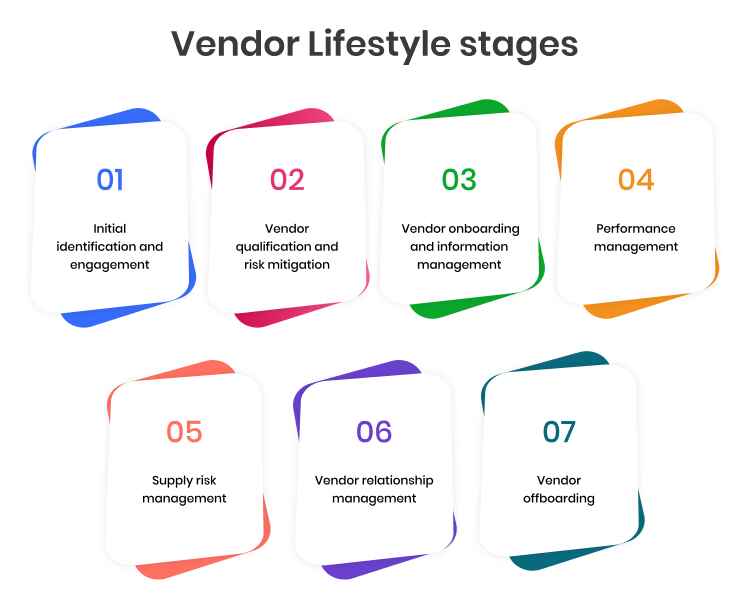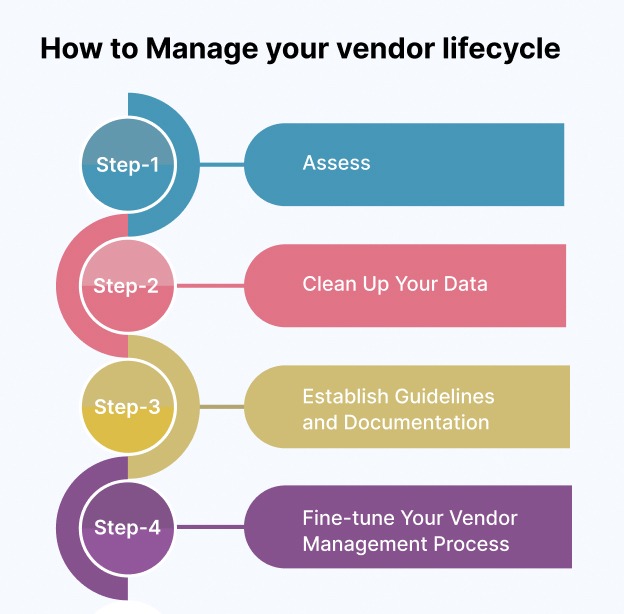 SAAS
SAAS

25 February, 2024

The vendor management lifecycle is a guideline that helps an organization find the right vendor. It has many stages that help you to make a plan and build a good relationship with vendors.
Well, are you looking for reliable information on the stages of vendor lifecycle for management? You have come to the right place! In this blog, you will learn about 7 steps of it with a detailed definition, management lifecycle, offering clear and practical guidance every step of the way.
As a business owner, understanding this process is essential to smoothing out your procurement journey and reducing risks. So, let’s begin the discussion with the definition of it.
Contents
The vendor management lifecycle is a series that guides vendors from start to finish. It ensures that every stage goes smoothly and is organized.
This lifecycle recognizes vendors’ importance and fits them into a different strategy. This “cradle to the grave” journey involves: finding vendors, checking qualifications, and choosing the best one.
It helps them start, by monitoring progress, managing risks, and building relationships. Good companies also regularly check their contracts to save money and improve terms.
Understanding the vendor lifecycle is essential for businesses. Vendors are important for providing the essentials a company needs to succeed.
Even startups can lay a solid foundation for growth by learning about this cycle. It takes control with the right tools and decisions.
Businesses can better manage vendor relationships when they understand how this cycle operates. They can streamline their procurement processes, and keep things running smoothly.
A survey shows that 80% of supply chain professionals believe that VML improves procurement efficiency.
So, knowing the vendor lifecycle well is essential for businesses to succeed and grow. Now, it is the time to learn about the vendor lifecycle stages.
To run your business operation smoothly, you must know about these steps.

The journey of this lifecycle starts by finding and reaching out to potential vendors. Smart companies focus on teaming up with vendors who share their values and ways of doing business.
They create a checklist of what they are looking for in a partner. It includes how they handle environmental issues, promote diversity, and support social causes.
These factors also work as conversation starters. Building a connection based on shared beliefs lays the foundation for a strong partnership.
Good communication is essential at this stage. You may ask why. The reason is it shapes how you will work together in the future. It goes beyond just a business deal
After the first stage, organizations move forward to evaluate potential vendors and minimize risks. This phase might involve comparing multiple vendors or pinpointing the most suitable one right away.
Regardless of the approach, it is essential to thoroughly assess each vendor’s offerings and address any potential partnership risks.
One aspect of risk evaluation involves checking if the vendor can handle the organization’s workload requirements.
Furthermore, organizations should assess vendors’ stability and long-term reliability to ensure consistent contract fulfillment. Checking finances and references reveals vendor dependability and expertise.
A recent survey shows us that, 70% of data breaches originate from third-party vendors, emphasizing the importance of VML in risk mitigation.
Once a vendor is chosen, it’s time to start the onboarding process. In this phase, vendors are linked to systems, share payment info, and set up how the communication will be done. Having specific contacts and clear roles keeps things straightforward for everyone involved.
Remember that documenting each step of the onboarding process is important. It helps create rules that can make working with vendors easier later on. Automation tools can also make things faster by assisting with tasks like defining contract terms and keeping track of performance.
You must keep track of how well vendors are doing. It helps in continuing a good relationship. Organizations use different tools and measures, like vendor scorecards and reviews, to see how much value vendors are bringing. These evaluations ensure that everyone is working towards the same goals.
Remember, understand the information properly and see trends, not just individual cases. By being open and working together, organizations can make sure vendors do their best.
A survey shows us that, 67% of companies consider strong vendor relationships as critical to their success, showcasing the value of effective VML in promoting collaboration.
Want to manage supply risk management? This is the vendor lifecycle stage where you do it. Handling supply chain risks has always been a challenge for organizations.
The reason is prices and demand keep changing, and some companies even close down. That is why it is important to plan and manage risks.
When you create easy contracts with vendors, it clarifies responsibilities and reduces uncertainties. This helps everyone understand what they need to do.
Additionally, using compatible automation tools can simplify tasks such as bill payments and invoicing, minimizing the risk of errors.
In vendor management, systems and processes are important. They help in building good relationships through effective communication and interaction.
Vendor relationship management means creating strong ties and solving problems quickly. This also includes avoiding disruptions from staff changes.
Remember that using a central communication hub and having several contacts helps reduce risks during staff changes. Dealing with issues early and working together improves vendor relationships for long-term success.
When relationships shift or situations change, organizations may need to end partnerships with vendors. Whether the vendor decides to leave or the organization chooses a new provider, it’s vital to handle the offboarding process well.
Documenting why the partnership ends and detailing the offboarding steps makes the transition smoother and keeps everyone accountable.
Continuous learning and adapting are important. usually, good documentation helps improve future processes.
In Vendor Lifecycle Management, it is important to avoid common mistakes. Avoiding mistakes ensures smooth operations and successful relationships.
You shouldn’t overlook background checks and risk assessments during vendor onboarding. It may lead to future complications. So, it is important to dedicate time to thorough due diligence to get potential risks from the outset.
The lack of clear metrics and service level agreements (SLAs) makes it difficult to assess. It becomes a challenge to manage vendor performance effectively. You must establish measurable metrics that can enhance relationships and outcomes.
Always remember that neglecting to identify and tackle risks. It can lead to the result in disruptions and financial setbacks. Combining regular risk assessments into your vendor management process is essential for mitigating potential issues.
Properly closing contracts and transitioning to new vendors is essential to prevent disruptions and complexities. Paying adequate attention to offboarding ensures a seamless transition.
Effective communication is essential for successful vendor management. Inadequate communication may lead to misunderstandings and strained relationships. So, maintaining open lines of communication and promptly addressing issues is critical.
Usually, to manage vendors, document, communicate, monitor, and reduce risks. Here, avoiding mistakes improves relationships.
Managing vendors effectively ensures that supplier relationships are productive and beneficial. Here are 9 practical ways to improve your vendor management lifecycle.
Let’s explore them together
Start by setting clear business goals that align with your organization’s objectives. Defining performance parameters helps prevent wasted resources. It helps you to perform a better vendor evaluation.
Choose vendors thoughtfully. Consider how well they fit with your company’s goals and Key Performance Indicators (KPIs). Look at factors like their resources, experience, and potential impact on your operations before making a decision.
Make risk management a priority throughout the lifecycle of vendor management. Conduct thorough due diligence before signing contracts. Remember to continue assessing risks during the supplier relationship. Focus on areas such as financial stability and data security to mitigate potential risks.
Contracts go beyond just agreeing on prices. They outline responsibilities and expectations for both parties. Negotiate clear terms covering confidentiality, dispute resolution, and data privacy. Communicate expectations clearly to avoid misunderstandings.
Efficient vendor onboarding is essential for smooth operations. Centralize vendor information collection and storage. It ensures flexibility for each vendor’s unique requirements.
Regular reporting and monitoring are important for effective supplier management. Keep track of vendor performance, risk management practices, and financials to identify and address issues. This approach encourages collaboration and communication.
Standardize vendor management activities by documenting the entire process from start to finish. This ensures consistency across the organization and serves as a reference for employees.
Effective communication is key to successful vendor management. Set up clear channels for negotiations, performance reviews, and issue resolution. Make sure everyone involved understands expectations, objectives, and priorities.
Build strong, lasting relationships with key vendors for positive results. Think about how you both can benefit and choose vendors that share your goals. Keep communication open and honest to nurture these relationships.
Do you have any questions regarding which of the following are management steps of the vendor lifecycle? Here, you will get your answer.
I will share the proper four steps to manage your vendor lifecycle. So. let’s explore these steps together.

Assessment is the starting point of managing the vendor lifecycle successfully. Take a close look at your current vendor management practices to pinpoint any areas that could use improvement. Collaborate with stakeholders to clarify who does what, and establish essential evaluation tools.
After completing the assessment step, shift your attention to improving data quality. This involves eliminating duplicate entries, fixing errors, and confirming accuracy.
It ensures that your data is reliable and is essential for making well-informed decisions. Usually, it helps to build strong vendor relationships.
In this step, you will establish clear guidelines, finalize vendor profiles, and document responsibilities. This ensures everyone is on the same page. Even, this step makes vendor management easy for everyone.
So, keep in mind that having these guidelines in place promotes teamwork. It also ensures consistency in how vendors are handled.
In the final stage, take a closer look at your vendor management process. Use technology to automate tasks, evaluate other parties involved, and enhance contract management.
Review contracts to save money and identify risks to improve vendor relationships. This step ensures smoother operations and better outcomes in vendor management.
By following these steps, businesses can effectively control their vendor management lifecycle process. It ensures smooth operations and minimizes risks along the way.
Finally, you must understand the vendor management lifecycle to optimize your business operations. By understanding it you can minimize risks and facilitate successful relationships.
By following the steps outlined in this blog, organizations can simplify their vendor management processes, enhance communication, mitigate risks, and drive long-term success.
Remember, continuous improvement and adaptation are important for managing vendor lifecycle and achieving business goals.